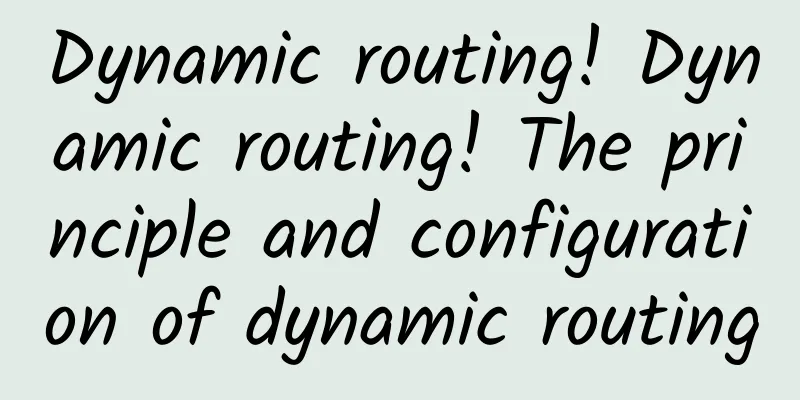Dynamic routing! Dynamic routing! The principle and configuration of dynamic routing

|
1. Introduction to dynamic routing 1. Dynamic routing Refers to the use of routing protocols by routers to learn about networks and update routing tables. 2. Routing protocol classification 3. Introduction to administrative distance Administrative distance (AD) is used to determine the credibility of routing information received from adjacent routers. It is an integer from 0 to 255, where 0 means the highest credibility and 255 means that no data flow will use the corresponding route. Default pipeline distance (Show ip protocols to view the AD value of dynamic routing) 4. Metrics A metric is a value that a routing protocol assigns to the cost of routing a network to a remote network. The metrics used in IP routing protocols are as follows: 5. Convergence
6. Distance Vector-Routing Loops (1) What is a routing loop? A routing loop is a phenomenon in which a data packet is continuously transmitted between a series of routers but never reaches its intended destination network. (2) Impact of routing loops
(3) Anti-loop mechanism
2. Update of RIP routing information 1. RIP routing information updates are based on time period updates (update period is 30 seconds) When the network topology connected to router A changes, router A updates its routing table and waits until the next sending cycle to announce the updated routing table. After receiving this update information, router B updates its own routing table 2. RIP configuration Configuration commands:
network Classified network (network10.0.0.0network tells the routing protocol RIP which classified networks to announce)
View the show ip route command The experimental environment is as follows: (1) Configure the IP address of router R2 interface and configure RIP routing (2) Set up routers R1 and R3 in the same way (3) View the routing table show ip route |
<<: "Feng Qingyang" Jack Ma will "retire" and look back at the 20 years of China's Internet trends
>>: Enterprise Network Data Communication Solution Practice - EIGRP
Recommend
360 Wang Yangdong: IOT devices require all-round security protection, and every detail cannot be ignored
[51CTO.com original article] On December 1-2, 201...
edgeNAT Korea/Hong Kong KVM 20% off, top up 500 yuan and get 100 yuan free
edgeNAT is a Chinese VPS hosting company establis...
Huawei and its medical industry partners promote 5G smart medical integration cooperation
In order to further respond to the national new i...
The key challenges facing MSPs and CMPs in “multi-cloud” are: Network
The rapid development of new cloud-based applicat...
5 false truths about 5G mobile phones, don't be fooled anymore
[[360004]] Although some things are real, they ar...
Justhost has launched its 22nd node in Türkiye, with 200Mbps unlimited VPS starting at $1.73 per month
Justhost.ru recently launched its 22nd VPS node: ...
5G Downlink Channel Sounding "CSI-RS"
Since 4G, the bandwidth of carriers has increased...
How to accelerate the scale application of 5G? Integration of thousands of industries is the key
Although 5G will enter a new stage of large-scale...
What is the network VRRP protocol, and can it really solve network stability issues?
With the rapid development of the Internet, vario...
Gartner: Global 5G network infrastructure spending will nearly double in 2020
Recently, according to the forecast of Gartner, a...
Adding more content rights makes 5G packages more popular
China Telecom's 5G package users have accumul...
From TCP to Socket, a thorough understanding of network programming
For students who are engaged in program developme...
A simple introduction to the consensus algorithm Raft
[[417323]] This article is reprinted from the WeC...
5G makes IP network a trillion-dollar market, and 8 years of network upgrades have been hard on operators
Through the concentrated bombardment of media pro...

![[11.11]edgeNAT: 40% off on all VPS, US/Hong Kong/Korea VPS monthly payment starts from 36 yuan, top up 500 yuan and get 100 yuan free](/upload/images/67cabd111d0f8.webp)







